Project Finance and Procurement: Risk Agreements and Motivations
VerifiedAdded on 2023/06/15
|8
|2216
|466
Report
AI Summary
This report provides an analysis of project finance and procurement, focusing on risk management strategies within a case study context. It identifies various risks including business, volatility, inflation, and currency risks, and evaluates how these risks can be managed through examples in the case study such as enforcement risks, project execution risks, and operational risks. The report also evaluates the role of risk agreements like Power Purchase Agreements (PPA), Engineering, Procurement and Construction (EPC) Agreements, and Operation & Maintenance (O&M) Agreements in managing risks from a project finance perspective. Furthermore, it discusses motivations for and against the EFC's advisory group investing in the venture, highlighting the potential for loan opportunities and financial construction benefits versus the risks associated with political instability. The conclusion emphasizes the challenges faced by Argentina's energy and power industry and the importance of strategic approaches to address these issues.
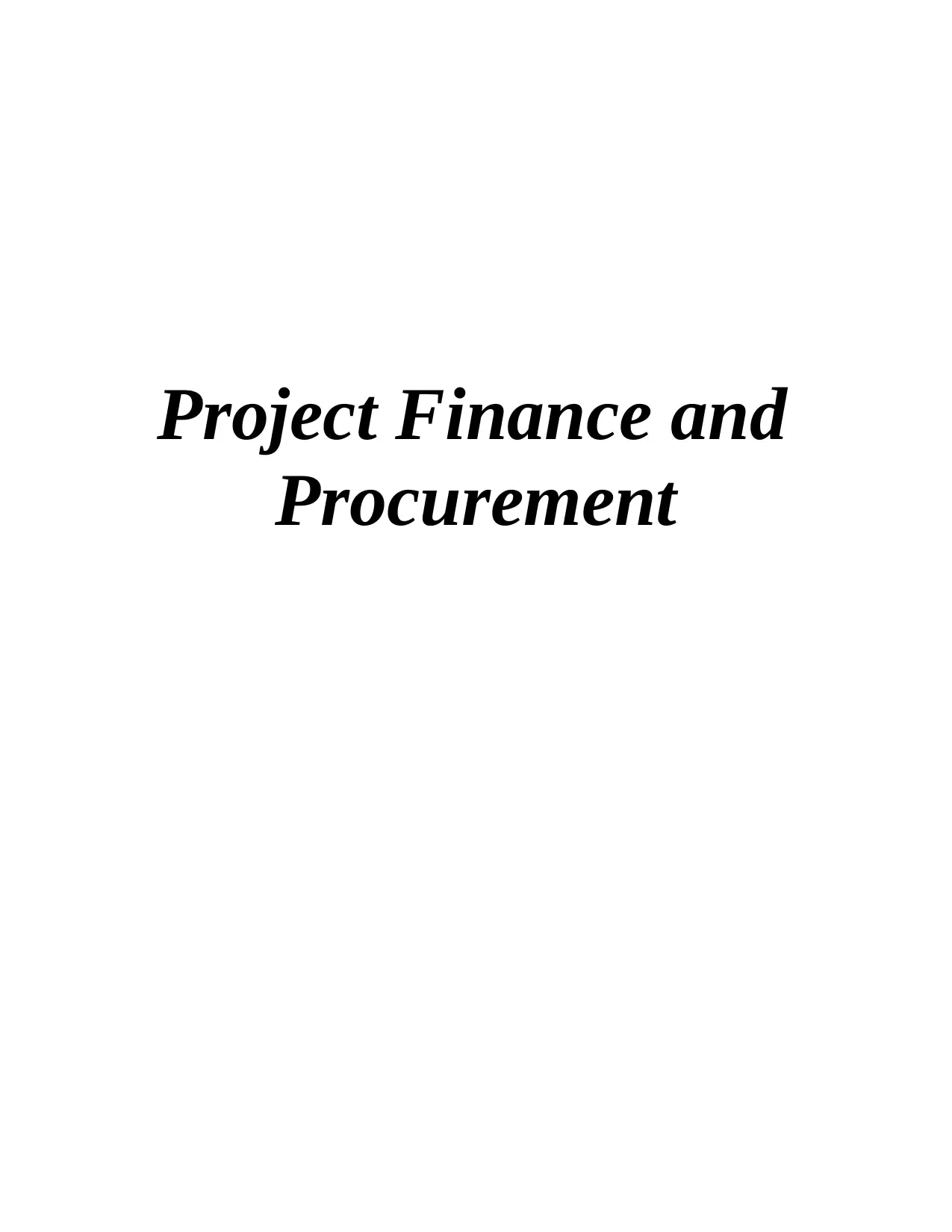
Project Finance and
Procurement
Procurement
Paraphrase This Document
Need a fresh take? Get an instant paraphrase of this document with our AI Paraphraser
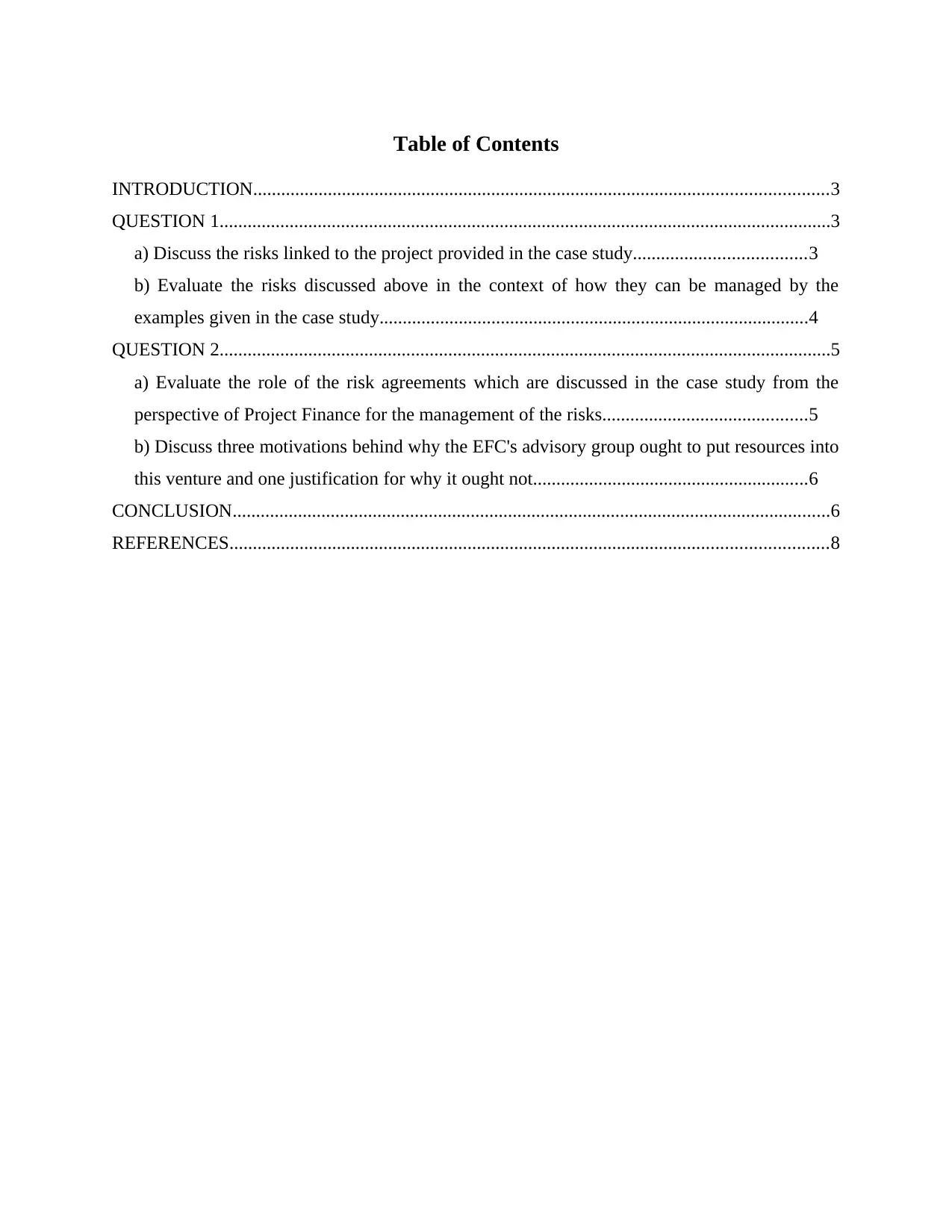
Table of Contents
INTRODUCTION...........................................................................................................................3
QUESTION 1...................................................................................................................................3
a) Discuss the risks linked to the project provided in the case study.....................................3
b) Evaluate the risks discussed above in the context of how they can be managed by the
examples given in the case study............................................................................................4
QUESTION 2...................................................................................................................................5
a) Evaluate the role of the risk agreements which are discussed in the case study from the
perspective of Project Finance for the management of the risks............................................5
b) Discuss three motivations behind why the EFC's advisory group ought to put resources into
this venture and one justification for why it ought not...........................................................6
CONCLUSION................................................................................................................................6
REFERENCES................................................................................................................................8
INTRODUCTION...........................................................................................................................3
QUESTION 1...................................................................................................................................3
a) Discuss the risks linked to the project provided in the case study.....................................3
b) Evaluate the risks discussed above in the context of how they can be managed by the
examples given in the case study............................................................................................4
QUESTION 2...................................................................................................................................5
a) Evaluate the role of the risk agreements which are discussed in the case study from the
perspective of Project Finance for the management of the risks............................................5
b) Discuss three motivations behind why the EFC's advisory group ought to put resources into
this venture and one justification for why it ought not...........................................................6
CONCLUSION................................................................................................................................6
REFERENCES................................................................................................................................8
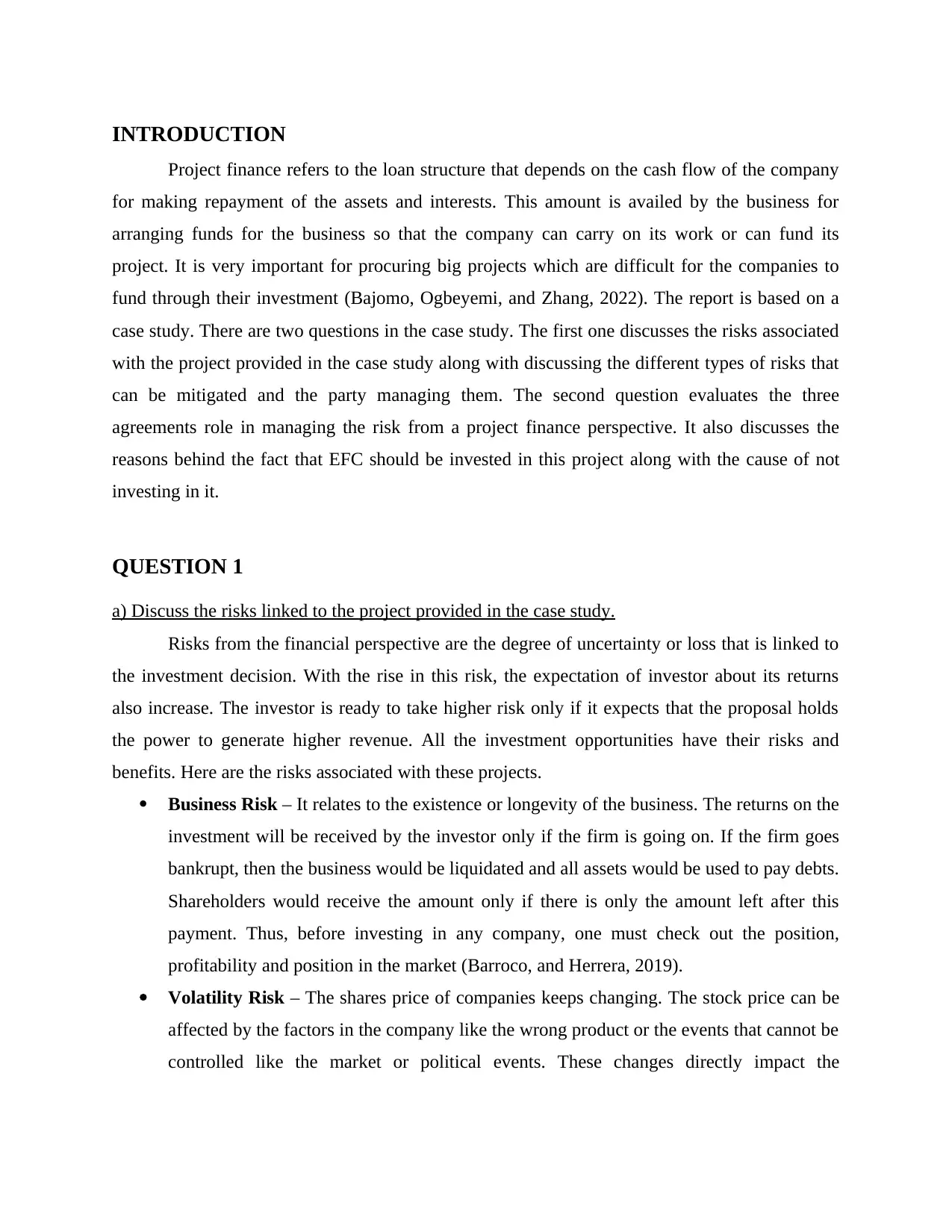
INTRODUCTION
Project finance refers to the loan structure that depends on the cash flow of the company
for making repayment of the assets and interests. This amount is availed by the business for
arranging funds for the business so that the company can carry on its work or can fund its
project. It is very important for procuring big projects which are difficult for the companies to
fund through their investment (Bajomo, Ogbeyemi, and Zhang, 2022). The report is based on a
case study. There are two questions in the case study. The first one discusses the risks associated
with the project provided in the case study along with discussing the different types of risks that
can be mitigated and the party managing them. The second question evaluates the three
agreements role in managing the risk from a project finance perspective. It also discusses the
reasons behind the fact that EFC should be invested in this project along with the cause of not
investing in it.
QUESTION 1
a) Discuss the risks linked to the project provided in the case study.
Risks from the financial perspective are the degree of uncertainty or loss that is linked to
the investment decision. With the rise in this risk, the expectation of investor about its returns
also increase. The investor is ready to take higher risk only if it expects that the proposal holds
the power to generate higher revenue. All the investment opportunities have their risks and
benefits. Here are the risks associated with these projects.
Business Risk – It relates to the existence or longevity of the business. The returns on the
investment will be received by the investor only if the firm is going on. If the firm goes
bankrupt, then the business would be liquidated and all assets would be used to pay debts.
Shareholders would receive the amount only if there is only the amount left after this
payment. Thus, before investing in any company, one must check out the position,
profitability and position in the market (Barroco, and Herrera, 2019).
Volatility Risk – The shares price of companies keeps changing. The stock price can be
affected by the factors in the company like the wrong product or the events that cannot be
controlled like the market or political events. These changes directly impact the
Project finance refers to the loan structure that depends on the cash flow of the company
for making repayment of the assets and interests. This amount is availed by the business for
arranging funds for the business so that the company can carry on its work or can fund its
project. It is very important for procuring big projects which are difficult for the companies to
fund through their investment (Bajomo, Ogbeyemi, and Zhang, 2022). The report is based on a
case study. There are two questions in the case study. The first one discusses the risks associated
with the project provided in the case study along with discussing the different types of risks that
can be mitigated and the party managing them. The second question evaluates the three
agreements role in managing the risk from a project finance perspective. It also discusses the
reasons behind the fact that EFC should be invested in this project along with the cause of not
investing in it.
QUESTION 1
a) Discuss the risks linked to the project provided in the case study.
Risks from the financial perspective are the degree of uncertainty or loss that is linked to
the investment decision. With the rise in this risk, the expectation of investor about its returns
also increase. The investor is ready to take higher risk only if it expects that the proposal holds
the power to generate higher revenue. All the investment opportunities have their risks and
benefits. Here are the risks associated with these projects.
Business Risk – It relates to the existence or longevity of the business. The returns on the
investment will be received by the investor only if the firm is going on. If the firm goes
bankrupt, then the business would be liquidated and all assets would be used to pay debts.
Shareholders would receive the amount only if there is only the amount left after this
payment. Thus, before investing in any company, one must check out the position,
profitability and position in the market (Barroco, and Herrera, 2019).
Volatility Risk – The shares price of companies keeps changing. The stock price can be
affected by the factors in the company like the wrong product or the events that cannot be
controlled like the market or political events. These changes directly impact the
⊘ This is a preview!⊘
Do you want full access?
Subscribe today to unlock all pages.

Trusted by 1+ million students worldwide
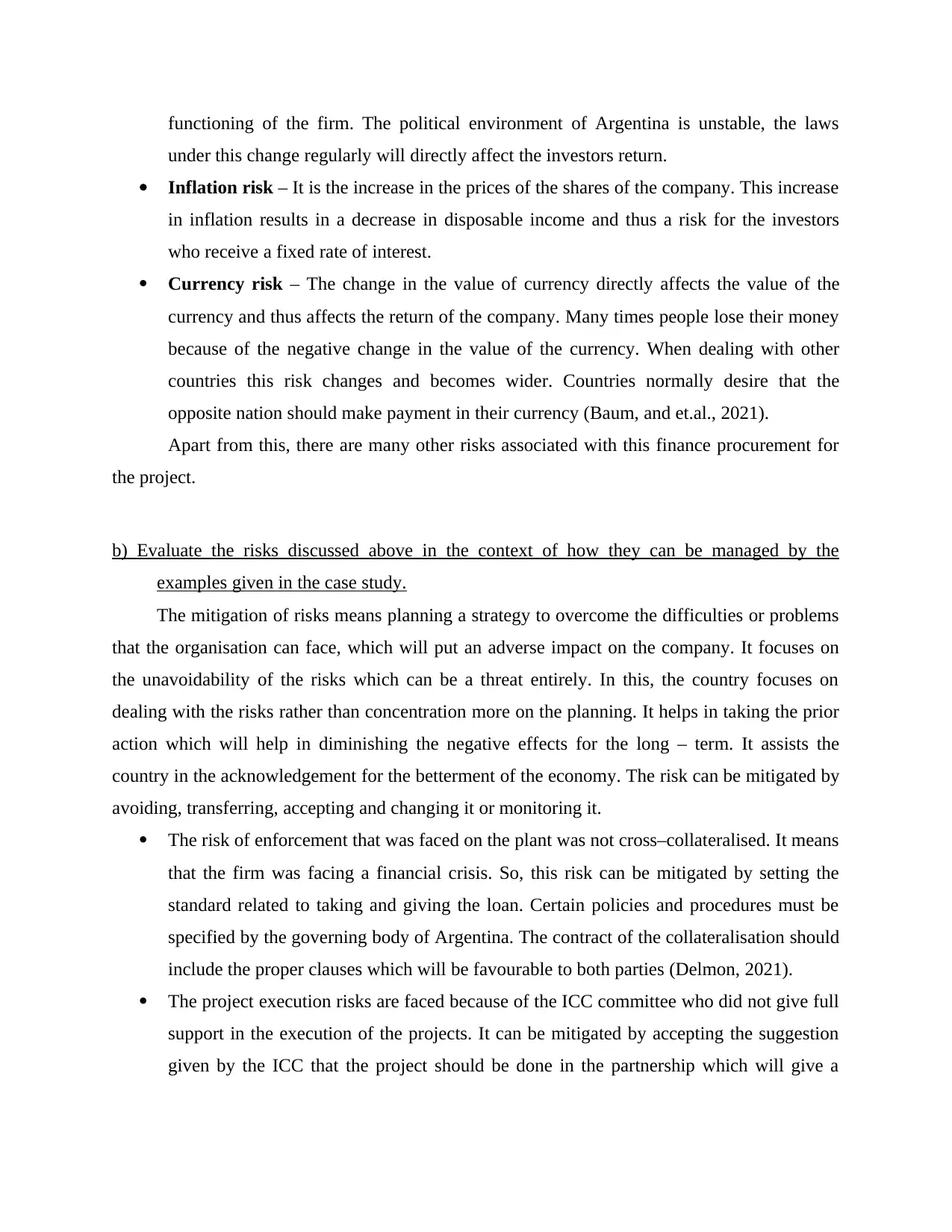
functioning of the firm. The political environment of Argentina is unstable, the laws
under this change regularly will directly affect the investors return.
Inflation risk – It is the increase in the prices of the shares of the company. This increase
in inflation results in a decrease in disposable income and thus a risk for the investors
who receive a fixed rate of interest.
Currency risk – The change in the value of currency directly affects the value of the
currency and thus affects the return of the company. Many times people lose their money
because of the negative change in the value of the currency. When dealing with other
countries this risk changes and becomes wider. Countries normally desire that the
opposite nation should make payment in their currency (Baum, and et.al., 2021).
Apart from this, there are many other risks associated with this finance procurement for
the project.
b) Evaluate the risks discussed above in the context of how they can be managed by the
examples given in the case study.
The mitigation of risks means planning a strategy to overcome the difficulties or problems
that the organisation can face, which will put an adverse impact on the company. It focuses on
the unavoidability of the risks which can be a threat entirely. In this, the country focuses on
dealing with the risks rather than concentration more on the planning. It helps in taking the prior
action which will help in diminishing the negative effects for the long – term. It assists the
country in the acknowledgement for the betterment of the economy. The risk can be mitigated by
avoiding, transferring, accepting and changing it or monitoring it.
The risk of enforcement that was faced on the plant was not cross–collateralised. It means
that the firm was facing a financial crisis. So, this risk can be mitigated by setting the
standard related to taking and giving the loan. Certain policies and procedures must be
specified by the governing body of Argentina. The contract of the collateralisation should
include the proper clauses which will be favourable to both parties (Delmon, 2021).
The project execution risks are faced because of the ICC committee who did not give full
support in the execution of the projects. It can be mitigated by accepting the suggestion
given by the ICC that the project should be done in the partnership which will give a
under this change regularly will directly affect the investors return.
Inflation risk – It is the increase in the prices of the shares of the company. This increase
in inflation results in a decrease in disposable income and thus a risk for the investors
who receive a fixed rate of interest.
Currency risk – The change in the value of currency directly affects the value of the
currency and thus affects the return of the company. Many times people lose their money
because of the negative change in the value of the currency. When dealing with other
countries this risk changes and becomes wider. Countries normally desire that the
opposite nation should make payment in their currency (Baum, and et.al., 2021).
Apart from this, there are many other risks associated with this finance procurement for
the project.
b) Evaluate the risks discussed above in the context of how they can be managed by the
examples given in the case study.
The mitigation of risks means planning a strategy to overcome the difficulties or problems
that the organisation can face, which will put an adverse impact on the company. It focuses on
the unavoidability of the risks which can be a threat entirely. In this, the country focuses on
dealing with the risks rather than concentration more on the planning. It helps in taking the prior
action which will help in diminishing the negative effects for the long – term. It assists the
country in the acknowledgement for the betterment of the economy. The risk can be mitigated by
avoiding, transferring, accepting and changing it or monitoring it.
The risk of enforcement that was faced on the plant was not cross–collateralised. It means
that the firm was facing a financial crisis. So, this risk can be mitigated by setting the
standard related to taking and giving the loan. Certain policies and procedures must be
specified by the governing body of Argentina. The contract of the collateralisation should
include the proper clauses which will be favourable to both parties (Delmon, 2021).
The project execution risks are faced because of the ICC committee who did not give full
support in the execution of the projects. It can be mitigated by accepting the suggestion
given by the ICC that the project should be done in the partnership which will give a
Paraphrase This Document
Need a fresh take? Get an instant paraphrase of this document with our AI Paraphraser
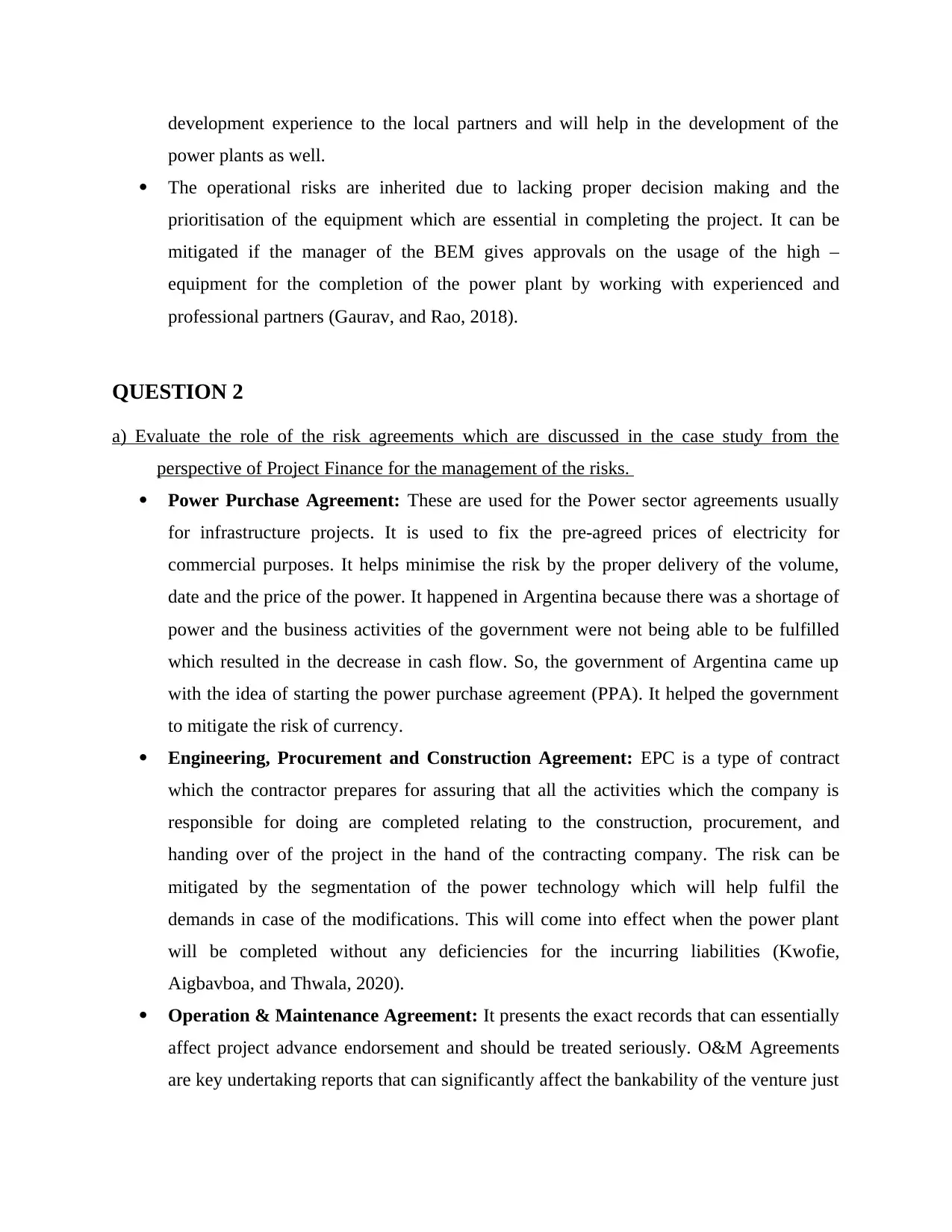
development experience to the local partners and will help in the development of the
power plants as well.
The operational risks are inherited due to lacking proper decision making and the
prioritisation of the equipment which are essential in completing the project. It can be
mitigated if the manager of the BEM gives approvals on the usage of the high –
equipment for the completion of the power plant by working with experienced and
professional partners (Gaurav, and Rao, 2018).
QUESTION 2
a) Evaluate the role of the risk agreements which are discussed in the case study from the
perspective of Project Finance for the management of the risks.
Power Purchase Agreement: These are used for the Power sector agreements usually
for infrastructure projects. It is used to fix the pre-agreed prices of electricity for
commercial purposes. It helps minimise the risk by the proper delivery of the volume,
date and the price of the power. It happened in Argentina because there was a shortage of
power and the business activities of the government were not being able to be fulfilled
which resulted in the decrease in cash flow. So, the government of Argentina came up
with the idea of starting the power purchase agreement (PPA). It helped the government
to mitigate the risk of currency.
Engineering, Procurement and Construction Agreement: EPC is a type of contract
which the contractor prepares for assuring that all the activities which the company is
responsible for doing are completed relating to the construction, procurement, and
handing over of the project in the hand of the contracting company. The risk can be
mitigated by the segmentation of the power technology which will help fulfil the
demands in case of the modifications. This will come into effect when the power plant
will be completed without any deficiencies for the incurring liabilities (Kwofie,
Aigbavboa, and Thwala, 2020).
Operation & Maintenance Agreement: It presents the exact records that can essentially
affect project advance endorsement and should be treated seriously. O&M Agreements
are key undertaking reports that can significantly affect the bankability of the venture just
power plants as well.
The operational risks are inherited due to lacking proper decision making and the
prioritisation of the equipment which are essential in completing the project. It can be
mitigated if the manager of the BEM gives approvals on the usage of the high –
equipment for the completion of the power plant by working with experienced and
professional partners (Gaurav, and Rao, 2018).
QUESTION 2
a) Evaluate the role of the risk agreements which are discussed in the case study from the
perspective of Project Finance for the management of the risks.
Power Purchase Agreement: These are used for the Power sector agreements usually
for infrastructure projects. It is used to fix the pre-agreed prices of electricity for
commercial purposes. It helps minimise the risk by the proper delivery of the volume,
date and the price of the power. It happened in Argentina because there was a shortage of
power and the business activities of the government were not being able to be fulfilled
which resulted in the decrease in cash flow. So, the government of Argentina came up
with the idea of starting the power purchase agreement (PPA). It helped the government
to mitigate the risk of currency.
Engineering, Procurement and Construction Agreement: EPC is a type of contract
which the contractor prepares for assuring that all the activities which the company is
responsible for doing are completed relating to the construction, procurement, and
handing over of the project in the hand of the contracting company. The risk can be
mitigated by the segmentation of the power technology which will help fulfil the
demands in case of the modifications. This will come into effect when the power plant
will be completed without any deficiencies for the incurring liabilities (Kwofie,
Aigbavboa, and Thwala, 2020).
Operation & Maintenance Agreement: It presents the exact records that can essentially
affect project advance endorsement and should be treated seriously. O&M Agreements
are key undertaking reports that can significantly affect the bankability of the venture just
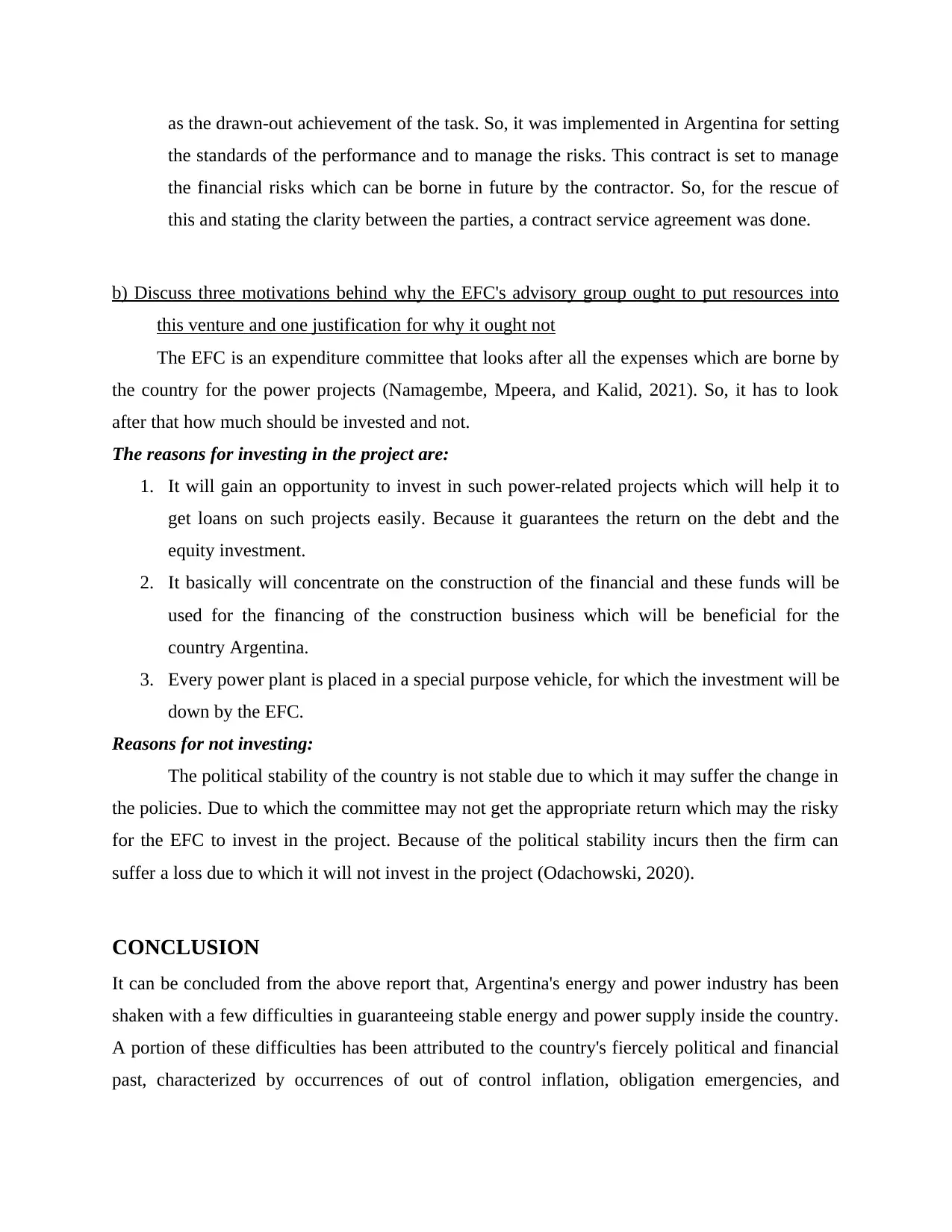
as the drawn-out achievement of the task. So, it was implemented in Argentina for setting
the standards of the performance and to manage the risks. This contract is set to manage
the financial risks which can be borne in future by the contractor. So, for the rescue of
this and stating the clarity between the parties, a contract service agreement was done.
b) Discuss three motivations behind why the EFC's advisory group ought to put resources into
this venture and one justification for why it ought not
The EFC is an expenditure committee that looks after all the expenses which are borne by
the country for the power projects (Namagembe, Mpeera, and Kalid, 2021). So, it has to look
after that how much should be invested and not.
The reasons for investing in the project are:
1. It will gain an opportunity to invest in such power-related projects which will help it to
get loans on such projects easily. Because it guarantees the return on the debt and the
equity investment.
2. It basically will concentrate on the construction of the financial and these funds will be
used for the financing of the construction business which will be beneficial for the
country Argentina.
3. Every power plant is placed in a special purpose vehicle, for which the investment will be
down by the EFC.
Reasons for not investing:
The political stability of the country is not stable due to which it may suffer the change in
the policies. Due to which the committee may not get the appropriate return which may the risky
for the EFC to invest in the project. Because of the political stability incurs then the firm can
suffer a loss due to which it will not invest in the project (Odachowski, 2020).
CONCLUSION
It can be concluded from the above report that, Argentina's energy and power industry has been
shaken with a few difficulties in guaranteeing stable energy and power supply inside the country.
A portion of these difficulties has been attributed to the country's fiercely political and financial
past, characterized by occurrences of out of control inflation, obligation emergencies, and
the standards of the performance and to manage the risks. This contract is set to manage
the financial risks which can be borne in future by the contractor. So, for the rescue of
this and stating the clarity between the parties, a contract service agreement was done.
b) Discuss three motivations behind why the EFC's advisory group ought to put resources into
this venture and one justification for why it ought not
The EFC is an expenditure committee that looks after all the expenses which are borne by
the country for the power projects (Namagembe, Mpeera, and Kalid, 2021). So, it has to look
after that how much should be invested and not.
The reasons for investing in the project are:
1. It will gain an opportunity to invest in such power-related projects which will help it to
get loans on such projects easily. Because it guarantees the return on the debt and the
equity investment.
2. It basically will concentrate on the construction of the financial and these funds will be
used for the financing of the construction business which will be beneficial for the
country Argentina.
3. Every power plant is placed in a special purpose vehicle, for which the investment will be
down by the EFC.
Reasons for not investing:
The political stability of the country is not stable due to which it may suffer the change in
the policies. Due to which the committee may not get the appropriate return which may the risky
for the EFC to invest in the project. Because of the political stability incurs then the firm can
suffer a loss due to which it will not invest in the project (Odachowski, 2020).
CONCLUSION
It can be concluded from the above report that, Argentina's energy and power industry has been
shaken with a few difficulties in guaranteeing stable energy and power supply inside the country.
A portion of these difficulties has been attributed to the country's fiercely political and financial
past, characterized by occurrences of out of control inflation, obligation emergencies, and
⊘ This is a preview!⊘
Do you want full access?
Subscribe today to unlock all pages.

Trusted by 1+ million students worldwide
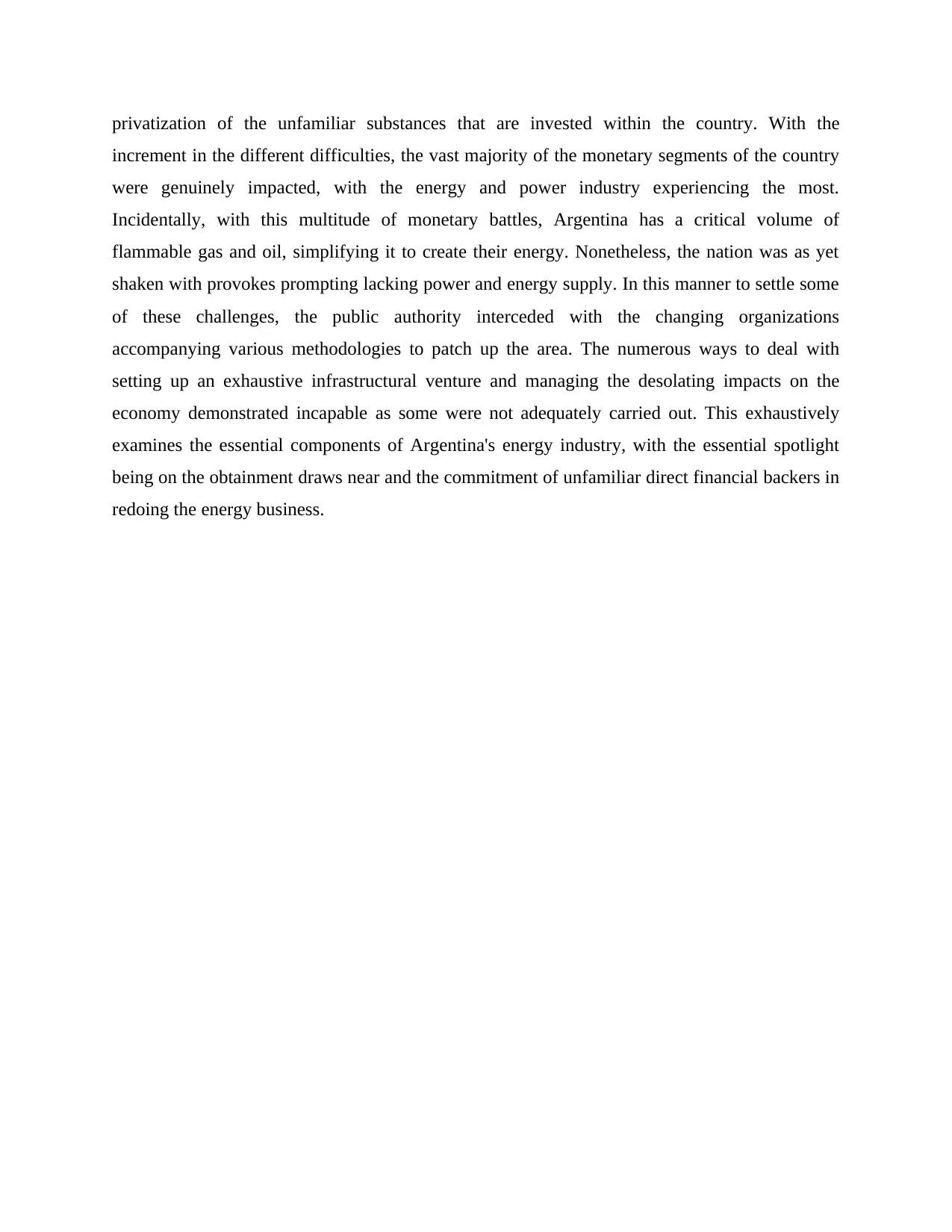
privatization of the unfamiliar substances that are invested within the country. With the
increment in the different difficulties, the vast majority of the monetary segments of the country
were genuinely impacted, with the energy and power industry experiencing the most.
Incidentally, with this multitude of monetary battles, Argentina has a critical volume of
flammable gas and oil, simplifying it to create their energy. Nonetheless, the nation was as yet
shaken with provokes prompting lacking power and energy supply. In this manner to settle some
of these challenges, the public authority interceded with the changing organizations
accompanying various methodologies to patch up the area. The numerous ways to deal with
setting up an exhaustive infrastructural venture and managing the desolating impacts on the
economy demonstrated incapable as some were not adequately carried out. This exhaustively
examines the essential components of Argentina's energy industry, with the essential spotlight
being on the obtainment draws near and the commitment of unfamiliar direct financial backers in
redoing the energy business.
increment in the different difficulties, the vast majority of the monetary segments of the country
were genuinely impacted, with the energy and power industry experiencing the most.
Incidentally, with this multitude of monetary battles, Argentina has a critical volume of
flammable gas and oil, simplifying it to create their energy. Nonetheless, the nation was as yet
shaken with provokes prompting lacking power and energy supply. In this manner to settle some
of these challenges, the public authority interceded with the changing organizations
accompanying various methodologies to patch up the area. The numerous ways to deal with
setting up an exhaustive infrastructural venture and managing the desolating impacts on the
economy demonstrated incapable as some were not adequately carried out. This exhaustively
examines the essential components of Argentina's energy industry, with the essential spotlight
being on the obtainment draws near and the commitment of unfamiliar direct financial backers in
redoing the energy business.
Paraphrase This Document
Need a fresh take? Get an instant paraphrase of this document with our AI Paraphraser
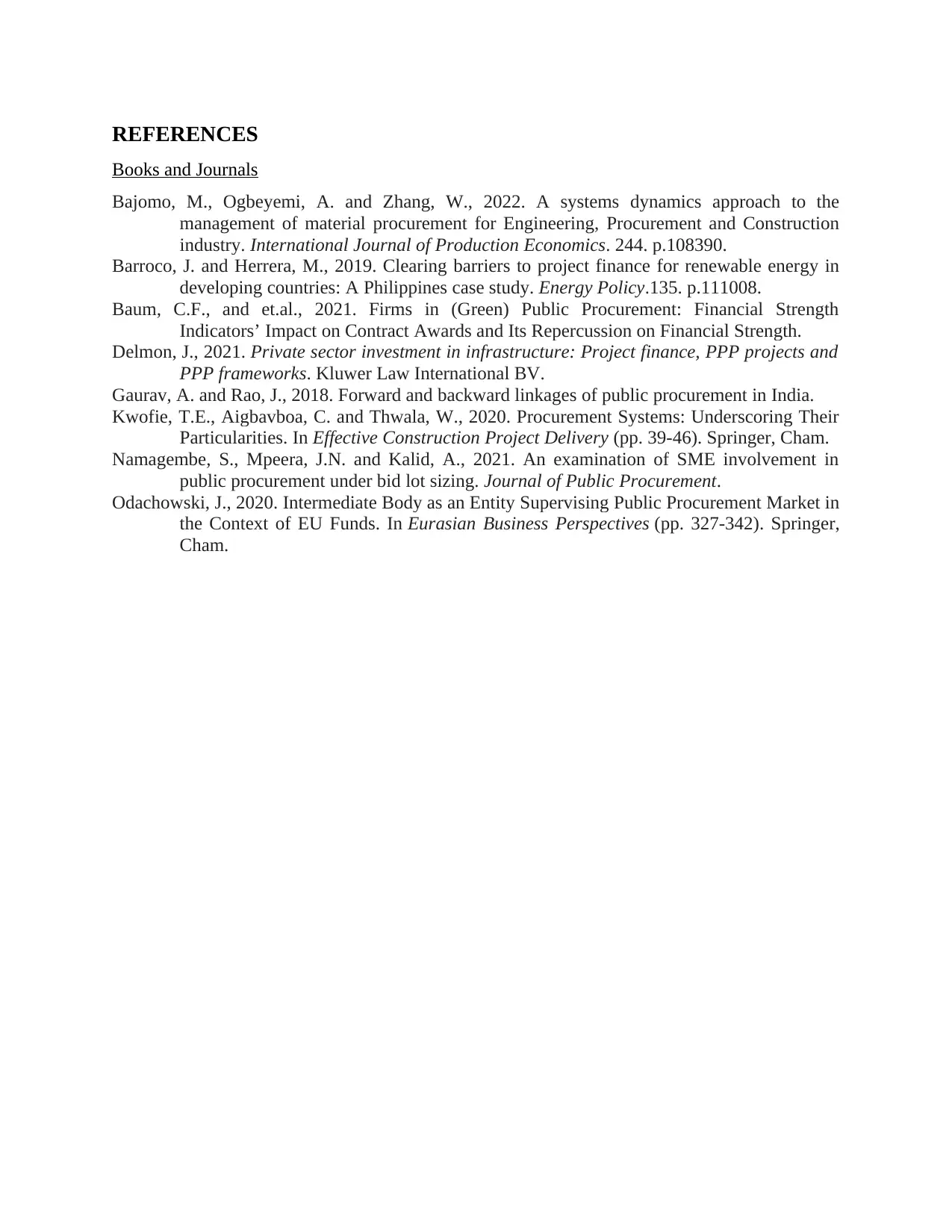
REFERENCES
Books and Journals
Bajomo, M., Ogbeyemi, A. and Zhang, W., 2022. A systems dynamics approach to the
management of material procurement for Engineering, Procurement and Construction
industry. International Journal of Production Economics. 244. p.108390.
Barroco, J. and Herrera, M., 2019. Clearing barriers to project finance for renewable energy in
developing countries: A Philippines case study. Energy Policy.135. p.111008.
Baum, C.F., and et.al., 2021. Firms in (Green) Public Procurement: Financial Strength
Indicators’ Impact on Contract Awards and Its Repercussion on Financial Strength.
Delmon, J., 2021. Private sector investment in infrastructure: Project finance, PPP projects and
PPP frameworks. Kluwer Law International BV.
Gaurav, A. and Rao, J., 2018. Forward and backward linkages of public procurement in India.
Kwofie, T.E., Aigbavboa, C. and Thwala, W., 2020. Procurement Systems: Underscoring Their
Particularities. In Effective Construction Project Delivery (pp. 39-46). Springer, Cham.
Namagembe, S., Mpeera, J.N. and Kalid, A., 2021. An examination of SME involvement in
public procurement under bid lot sizing. Journal of Public Procurement.
Odachowski, J., 2020. Intermediate Body as an Entity Supervising Public Procurement Market in
the Context of EU Funds. In Eurasian Business Perspectives (pp. 327-342). Springer,
Cham.
Books and Journals
Bajomo, M., Ogbeyemi, A. and Zhang, W., 2022. A systems dynamics approach to the
management of material procurement for Engineering, Procurement and Construction
industry. International Journal of Production Economics. 244. p.108390.
Barroco, J. and Herrera, M., 2019. Clearing barriers to project finance for renewable energy in
developing countries: A Philippines case study. Energy Policy.135. p.111008.
Baum, C.F., and et.al., 2021. Firms in (Green) Public Procurement: Financial Strength
Indicators’ Impact on Contract Awards and Its Repercussion on Financial Strength.
Delmon, J., 2021. Private sector investment in infrastructure: Project finance, PPP projects and
PPP frameworks. Kluwer Law International BV.
Gaurav, A. and Rao, J., 2018. Forward and backward linkages of public procurement in India.
Kwofie, T.E., Aigbavboa, C. and Thwala, W., 2020. Procurement Systems: Underscoring Their
Particularities. In Effective Construction Project Delivery (pp. 39-46). Springer, Cham.
Namagembe, S., Mpeera, J.N. and Kalid, A., 2021. An examination of SME involvement in
public procurement under bid lot sizing. Journal of Public Procurement.
Odachowski, J., 2020. Intermediate Body as an Entity Supervising Public Procurement Market in
the Context of EU Funds. In Eurasian Business Perspectives (pp. 327-342). Springer,
Cham.
1 out of 8
Related Documents
Your All-in-One AI-Powered Toolkit for Academic Success.
+13062052269
info@desklib.com
Available 24*7 on WhatsApp / Email
![[object Object]](/_next/static/media/star-bottom.7253800d.svg)
Unlock your academic potential
Copyright © 2020–2025 A2Z Services. All Rights Reserved. Developed and managed by ZUCOL.





